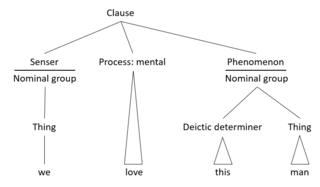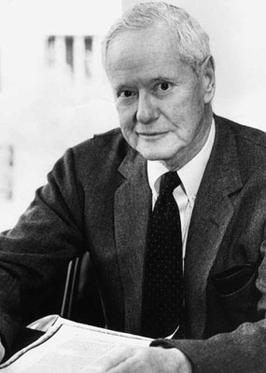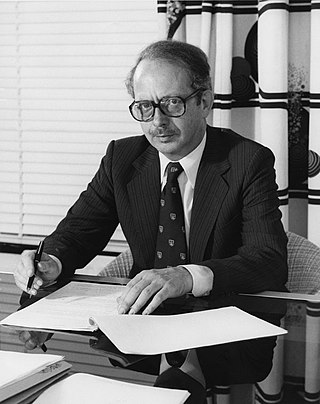
Functional linguistics is an approach to the study of language characterized by taking systematically into account the speaker's and the hearer's side, and the communicative needs of the speaker and of the given language community. Linguistic functionalism spawned in the 1920s to 1930s from Ferdinand de Saussure's systematic structuralist approach to language (1916).

In sociology, anthropology, archaeology, history, philosophy, and linguistics, structuralism is a general theory of culture and methodology that implies that elements of human culture must be understood by way of their relationship to a broader system. It works to uncover the structures that underlie all the things that humans do, think, perceive, and feel.

Robert King Merton was an American sociologist who is considered a founding father of modern sociology, and a major contributor to the subfield of criminology. He served as the 47th president of the American Sociological Association. He spent most of his career teaching at Columbia University, where he attained the rank of University Professor. In 1994 he was awarded the National Medal of Science for his contributions to the field and for having founded the sociology of science.

Structural functionalism, or simply functionalism, is "a framework for building theory that sees society as a complex system whose parts work together to promote solidarity and stability".

Ralf Gustav Dahrendorf, Baron Dahrendorf, was a German-British sociologist, philosopher, political scientist and liberal politician. A class conflict theorist, Dahrendorf was a leading expert on explaining and analysing class divisions in modern society. Dahrendorf wrote multiple articles and books, his most notable being Class Conflict in Industrial Society (1959) and Essays in the Theory of Society (1968).

In the social sciences, social structure is the aggregate of patterned social arrangements in society that are both emergent from and determinant of the actions of individuals. Likewise, society is believed to be grouped into structurally related groups or sets of roles, with different functions, meanings, or purposes. Examples of social structure include family, religion, law, economy, and class. It contrasts with "social system", which refers to the parent structure in which these various structures are embedded. Thus, social structures significantly influence larger systems, such as economic systems, legal systems, political systems, cultural systems, etc. Social structure can also be said to be the framework upon which a society is established. It determines the norms and patterns of relations between the various institutions of the society.

Alfred Reginald Radcliffe-Brown, FBA was an English social anthropologist who helped further develop the theory of structural functionalism.

A cultural system is the interaction of different elements in culture. While a cultural system is very different from a social system, sometimes both systems together are referred to as the sociocultural system.

This is an index of sociology articles. For a shorter list, see List of basic sociology topics.

Macrosociology is a large-scale approach to sociology, emphasizing the analysis of social systems and populations at the structural level, often at a necessarily high level of theoretical abstraction. Though macrosociology does concern itself with individuals, families, and other constituent aspects of a society, it does so in relation to larger social system of which such elements are a part. The approach is also able to analyze generalized collectivities.
The structure of a thing is how the parts of it relate to each other, how it is "assembled".
Humanistic sociology is a domain of sociology which originated mainly from the work of the University of Chicago Polish philosopher-turned-sociologist, Florian Znaniecki. It is a methodology which treats its objects of study and its students, that is, humans, as composites of values and systems of values. In certain contexts, the term is related to other sociological domains such as antipositivism. Humanistic sociology seeks to shed light on questions such as, "What is the relationship between a man of principle and a man of opportunism?"
Glossematics is a structuralist linguistic theory proposed by Louis Hjelmslev and Hans Jørgen Uldall although the two ultimately went separate ways each with their own approach. Hjelmslev’s theory, most notably, is an early mathematical methodology for the analysis of language which was subsequently incorporated into the analytical foundation of current models of functional—structural grammar such as Danish Functional Grammar, Functional Discourse Grammar and Systemic Functional Linguistics. Hjelmslev’s theory likewise remains fundamental for modern semiotics.

A sociological theory is a supposition that intends to consider, analyze, and/or explain objects of social reality from a sociological perspective, drawing connections between individual concepts in order to organize and substantiate sociological knowledge. Hence, such knowledge is composed of complex theoretical frameworks and methodology.
Middle-range theory, developed by Robert K. Merton, is an approach to sociological theorizing aimed at integrating theory and empirical research. It is currently the de facto dominant approach to sociological theory construction, especially in the United States.

Social Theory and Social Structure (STSS) was a landmark publication in sociology by Robert K. Merton. It has been translated into close to 20 languages and is one of the most frequently cited texts in social sciences. It was first published in 1949, although revised editions of 1957 and 1968 are often cited. In 1998 the International Sociological Association listed this work as the third most important sociological book of the 20th century.

The sociology of education is the study of how public institutions and individual experiences affect education and its outcomes. It is mostly concerned with the public schooling systems of modern industrial societies, including the expansion of higher, further, adult, and continuing education.

Sociology is a social science that focuses on society, human social behavior, patterns of social relationships, social interaction, and aspects of culture associated with everyday life. It uses various methods of empirical investigation and critical analysis to develop a body of knowledge about social order and social change. While some sociologists conduct research that may be applied directly to social policy and welfare, others focus primarily on refining the theoretical understanding of social processes and phenomenological method. Subject matter can range from micro-level analyses of society to macro-level analyses.

In sociology, action theory is the theory of social action presented by the American theorist Talcott Parsons.
Theory of language is a topic from philosophy of language and theoretical linguistics. It has the goal of answering the questions "What is language?"; "Why do languages have the properties they have?"; or "What is the origin of language?".








